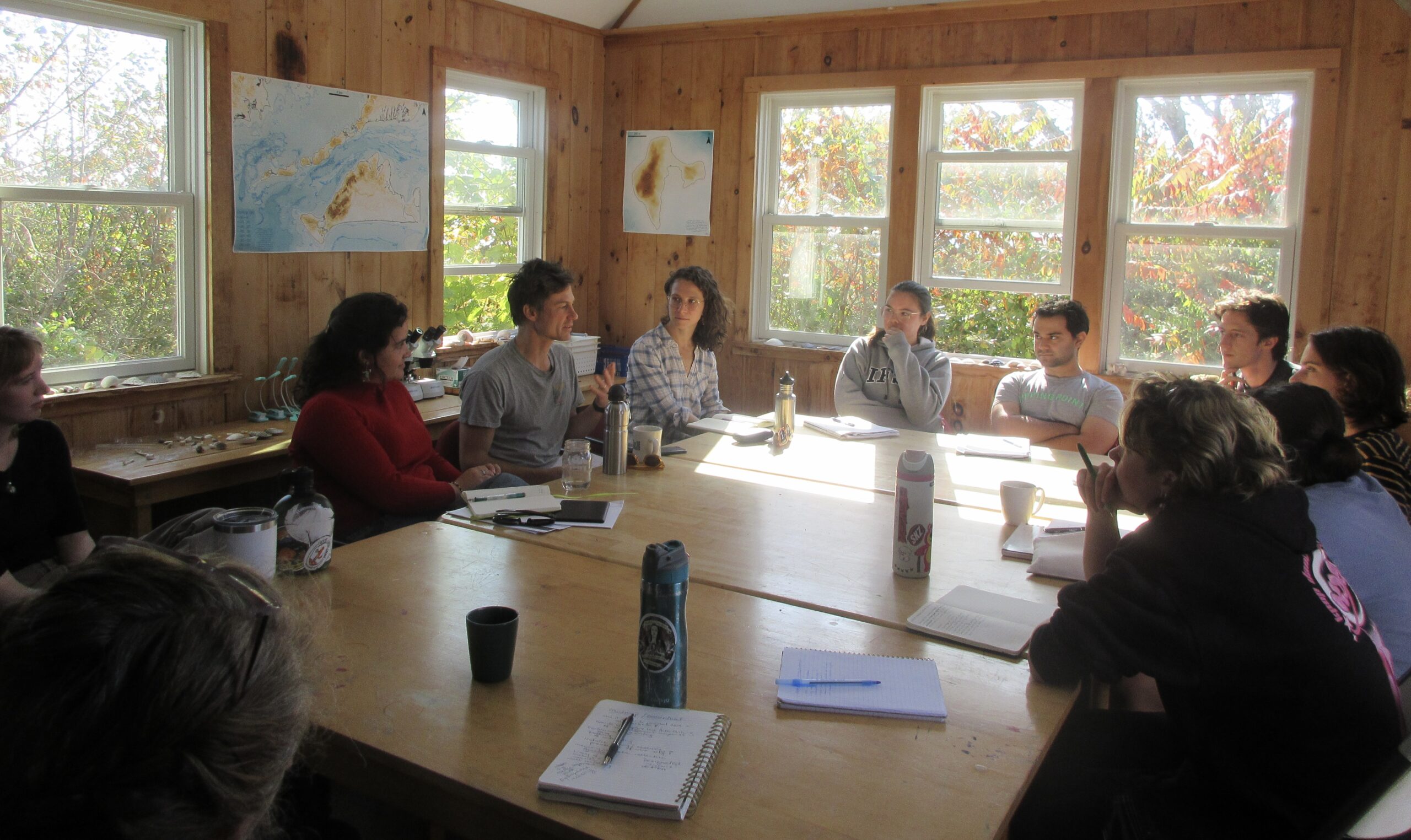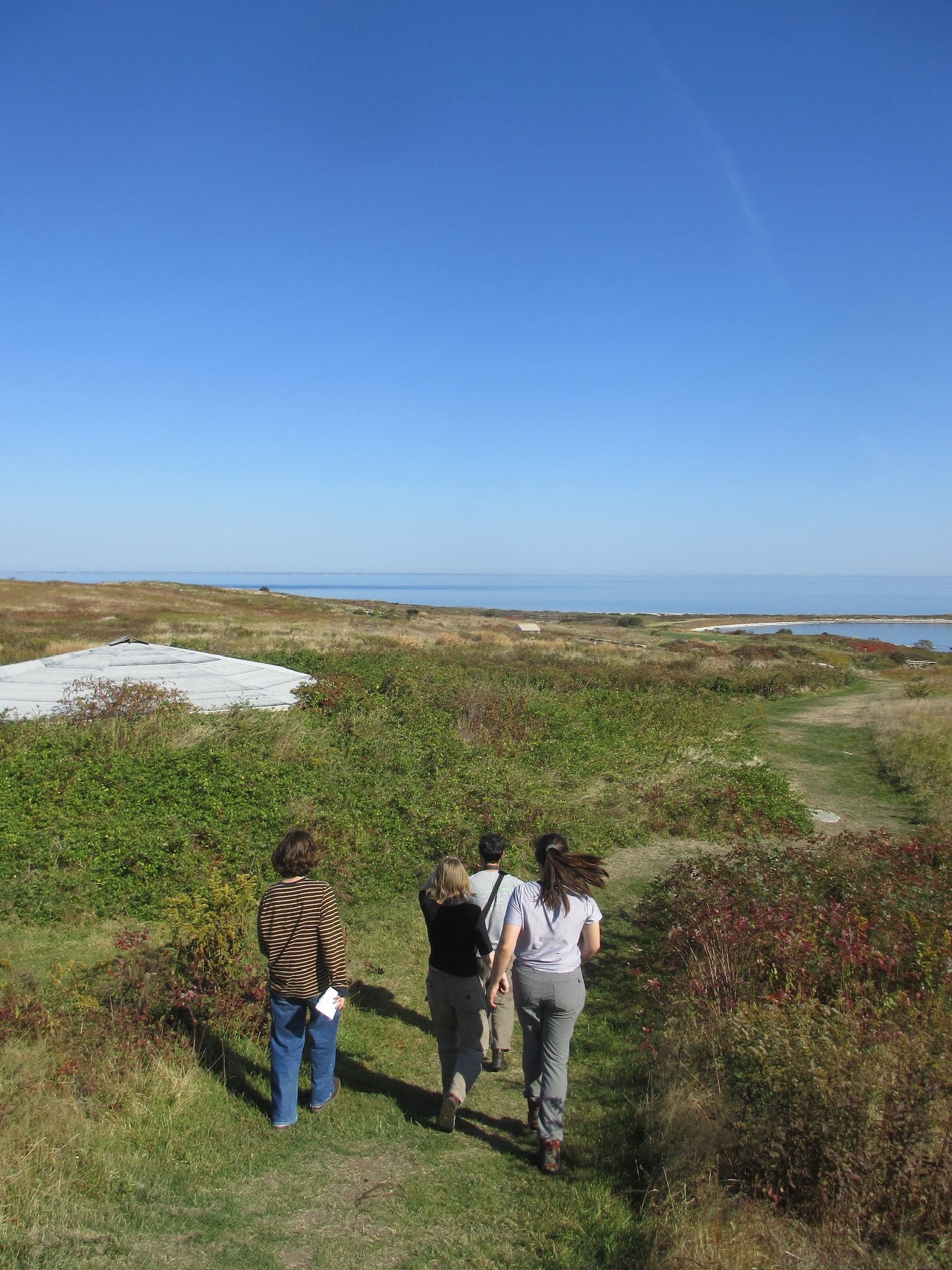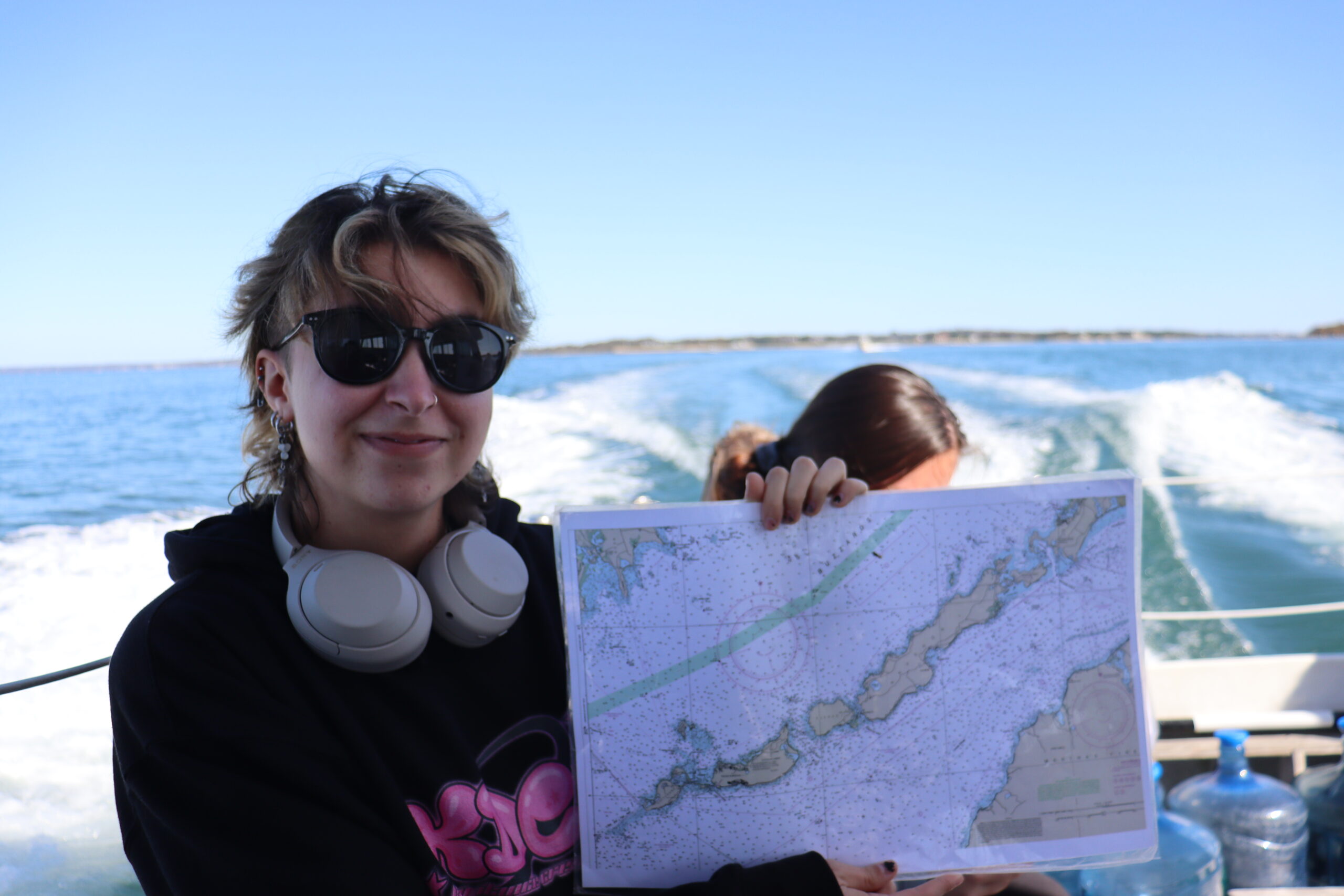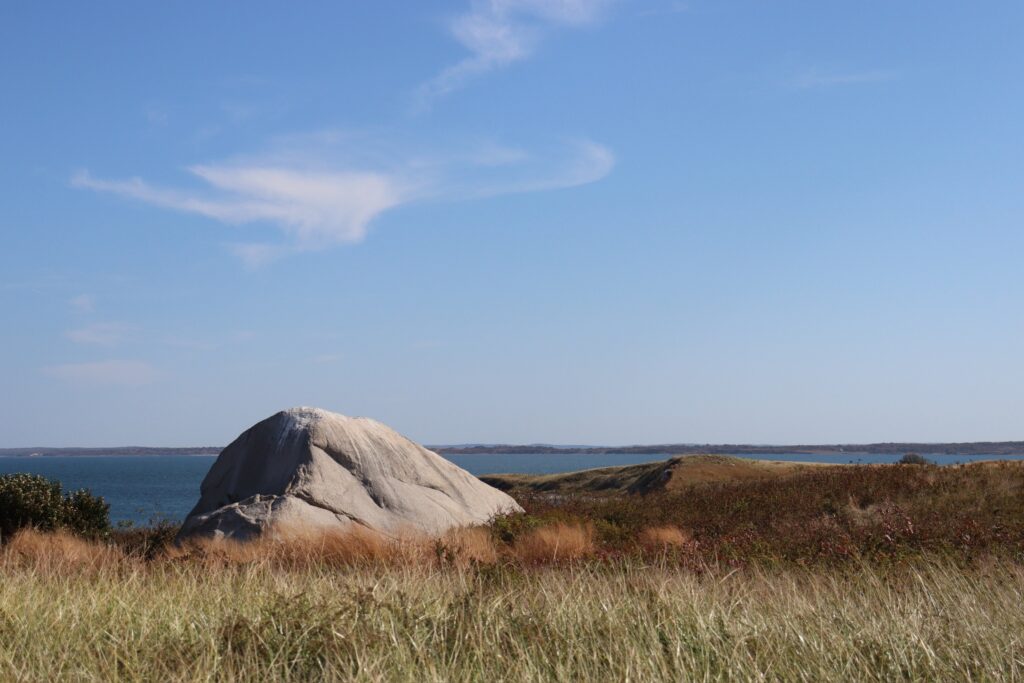Academics & Seminar on Penikese Island
What did it mean to learn on Penikese Island?
This section explores the academic dimensions of the Penikese Island trip, where students integrated classroom learning with lived experiences. Through seminars, self-governance, and labor, participants engaged with key texts and questions about personhood, ecological relationships, and the role of place in knowledge creation. Reflections highlight how discussions on readings like Braiding Sweetgrass and God is Red came alive through interactions with the island’s landscape, history, and community, fostering a holistic and embodied approach to learning.
Academics, Seminar & Ways of Knowing
During our last class before fall break, we turned with new focus to a simple question: what did we really hope to get out of the Penikese Island trip?
We talked about escaping the routines of our lives at Wesleyan; our interest in learning outside the traditional classroom; and personal hopes of gaining some perspective, connecting with nature, ourselves, and each other. On the question of learning outside the classroom, we asked ourselves what it would look like – if indeed it could be possible – to do serious academic work of a kind that might be validated by the university system while genuinely embracing a collective, non-self-centered orientation, and taking seriously the role of the place we inhabit as a social actor in our collective learning.


Seminar
The experience of traveling to the island and adjusting to the structure of the days helped push us all to be sincerely present in the moment, and the unfamiliar elements of self-governance and physical labor on the island seemed to draw our attention more than the familiar seminar-style academics.
Yet what I think made this trip so remarkable was the way in which the ideas and texts which we had encountered at Wesleyan and in the island’s schoolhouse insistently arose in unexpected places– like mushrooms pushing up from the earth. Conversations tangled and reappeared, rising out of mealtime discussions, shared labor sessions, walks during free hours, self-governance and the subsequent down time – and they took new forms at the seminar table. The different modes of thinking complemented one another. Personal and emotional reactions to experiences guided us towards bigger ideas about what we were engaging in.

Seminar Session: Sunday
- Visit from Nitana Hicks Greendeer (Wampanoag language reclamation project, Professor at Brown University).
- We learned about Mashpee and its history
- We talked about Wampanoag language – ways of naming things and the nature of the reclamation project.
- We thought through our personal relationships to the landscapes with which we are familiar
- Greendeer helped us think about relating a mooring in the past to the constantly changing future – raising younger generations.
- We talked about Eliot’s Bible – a translation made for conversion of indigenous groups to Christianity
Seminar Session: Monday
- In preparation we read Genesis & Louis Agassiz’s essay on classification, and a selection of other Agassiz-related documents
- This discussion was led and structured by Justin and Ana
- We began by gathering our thoughts on the readings, coming up with one question or passage to investigate
- Our discussion focused on Agassiz’s worldview — his relationship to nature and God, and his understanding of knowledge
- On Monday night we had a self-governance meeting to determine how we wanted to run seminar for the final morning – the faculty asked the students to lead the class.
Seminar Session: Tuesday
- We discussed plans and goals for this website
- Students posed a few pre-planned discussion topics, which we discussed for a set amount of time
- Everyone was asked to contribute a takeaway question that felt important to them. We took these questions with us for a “walk and talk” around the island to conclude the seminar.

Takeaway Ideas
Ideas that we read in Braiding Sweetgrass by Robin Wall Kimmerer about intimacy and gift relationships informed our interaction with ideas about labor and different ways of knowing. Our labor was a way of engaging in a social relationship with the land but also with one another – we cooked for each other, cleaned, and paid attention to the way we inhabited shared space. This set of gift-relationships contributed to a sense that we co-created our island experience, rather than simply having it provided to us.
Our readings of Vine Deloria, God is Red, provided a background against which to see the ideas of Agassiz. The kind of spiritual life that Agassiz may have seen in the landscapes which were, for him, the enactment of God’s perfect plan of creation, might have some of the elements of an “animate landscape” in that meaning and intention can be understood behind each element of the earth. Yet it is a kind of “animacy” that struck many of us as extremely different from that which might arise from a more social and dynamic set of relationships with the land. Deloria, talking about sacred spaces, and Lynn White (“The Historical Roots of our Ecological Crisis”), writing about the Christian history of the West and its role in the ecological crisis, pointed to a sense that a Christian worldview in which everything was once created and now humans live in the aftermath – fallen, looking at the world for typographic resonances – does little to encourage a real and living relationship with the landscapes around us. Deloria writes about sacred places as sites for renewed and repeated revelation – while Christian revelation is about one revelation that must make sense of everything everywhere forever.
Irving Hallowell’s characterization of “other-than-human-persons” (in “Ojibwa Ontology, Behavior, and World View”) seemed to linger with us on the island – we considered how the house, traces of previous lives on the island, and elements of the natural environment, each interacted with us as persons. The governmental protection of the island as a bird sanctuary also recalled the more legal sense of other-than-human persons which was pointed to by the introductory article we read for class – Justin Smith’s “Nature is Becoming a Person” (Foreign Policy, Nov. 24, 2021). Part of our labor on the island was in response to the government’s sense of which “natural persons” required their advocacy – they indicated which tree saplings to cut down based on their sense of the prioritized needs of the island and its non-human inhabitants.
Takeaway Questions
How do we relate specific practices of noticing and observation to the larger concept of “Observation”?
- What scientific resonances does that word hold, and what are their implications? In practices such as photography, who has agency? What transformations take place in the subject, object, viewer? How do such practices relate to memory?
What does it mean to be a visitor or guest?
- How can these terms be understood in relation to inhabiting, to lineage, to the concept of “becoming native”?
- What are the responsibilities of a visitor?
- How do these identities relate to temporality?
How will we remember this experience? What can we take away with us, and what should we take away with us?
- How will our intentions determine our future perceptions of the trip?
- What are the differences between memory and data capture?
- How will the land remember us?
How is the experience on Penikese Island shaped by its being an island?
- What changes in our relationship to the land when we see it in conversation with our relationship to the water?
- How isolated are we on the island?
How does building community inform knowledge?
- Through time and labor we constructed community. This community became visible through our variety of conversations – personal, intellectual, academic, philosophical. How does this shape the knowledge we hold?
What about our experience on the island attuned us to our own pasts?
- How did experience on the island prompt our ways of thinking about the island’s own history?
How might the pedagogy of this institute subvert the pedagogies of Agassiz? Of the other institutes from this island’s past?
Does knowledge need justification? Are we capable of satisfactory justification given our position in reality?
- How should we think about intimate individual knowledge as opposed to systemic, all-encompassing meaning?
- Does human understanding complete nature?
What ways of knowing came up for us during this time? Beyond the often-privileged sense of sight, what are other, embodied ways of learning and knowing the land?
Is this an animate landscape?
- For who? What kind?
- Was the landscape animate for Agassiz?
- Does the island recognize what people come there to do?
What does it mean to live well? What are the skills, the time, needed?
- Does knowledge of a place change the ways you interact with it?
